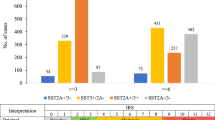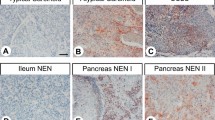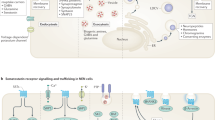Abstract
We have compared the expression of somatostatin receptor (sstr) subtypes with the outcome of somatostatin receptor scintigraphy and the effect of somatostatin receptor activation in patients with disseminated carcinoid tumours. Tumour tissues from nine patients with midgut carcinoids (ileal) and three patients with foregut carcinoids (gastric, thymic) were analysed using Northern blotting. Expression of somatostatin receptors was demonstrated in all tumours (12 out of 12), with all five receptor subtypes present in 9 out of 12 tumours. Somatostatin receptor scintigraphy using [111In]DTPA-D-Phe1-octreotide visualized tumours in all patients (12 out of 12). The 111In activity concentrations in tumour tissue (T) and blood (B) were determined in three tumours 1-7 days after injection of the radionuclide. The T/B 111In activity concentration ratios ranged between 32 and 651. Clinically, treatment with the long-acting somatostatin analogue octreotide resulted in marked symptom relief accompanied by a significant reduction in tumour markers, for example urinary-5-HIAA levels (28-71% reduction). Incubation of midgut carcinoid tumours in primary culture with octreotide (10 microM) resulted in a reduction in spontaneously secreted serotonin (45-71% reduction) and 5-HIAA (41-94% reduction). The results demonstrate that carcinoid tumours possess multiple somatostatin receptor subtypes and that somatostatin analogues such as octreotide, which preferentially bind to somatostatin receptor subtype 2 and 5, can be used in the diagnosis and medical treatment of these tumours. In the future, novel somatostatin analogues with subtype specific receptor profiles may prove to be of value for individualizing the treatment of disseminated carcinoid tumour disease.
This is a preview of subscription content, access via your institution
Access options
Subscribe to this journal
Receive 24 print issues and online access
$259.00 per year
only $10.79 per issue
Buy this article
- Purchase on Springer Link
- Instant access to full article PDF
Prices may be subject to local taxes which are calculated during checkout
Similar content being viewed by others
Author information
Authors and Affiliations
Rights and permissions
About this article
Cite this article
Nilsson, O., Kölby, L., Wängberg, B. et al. Comparative studies on the expression of somatostatin receptor subtypes, outcome of octreotide scintigraphy and response to octreotide treatment in patients with carcinoid tumours. Br J Cancer 77, 632–637 (1998). https://doi.org/10.1038/bjc.1998.101
Issue Date:
DOI: https://doi.org/10.1038/bjc.1998.101
This article is cited by
-
Prescription patterns of somatostatin analogs in patients with acromegaly and neuroendocrine tumors
Journal of Endocrinological Investigation (2022)
-
Safety, tolerability, pharmacokinetics, and pharmacodynamics of a long-acting release (LAR) formulation of pasireotide (SOM230) in patients with gastroenteropancreatic neuroendocrine tumors: results from a randomized, multicenter, open-label, phase I study
Cancer Chemotherapy and Pharmacology (2013)
-
Phenotyping of pulmonary carcinoids and a Ki-67-based grading approach
Virchows Archiv (2012)
-
Duodenal somatostatinoma
Hellenic Journal of Surgery (2010)
-
Immunohistochemical expression of somatostatin type 2A receptor in neuroendocrine carcinoma of uterine cervix
Archives of Gynecology and Obstetrics (2009)



